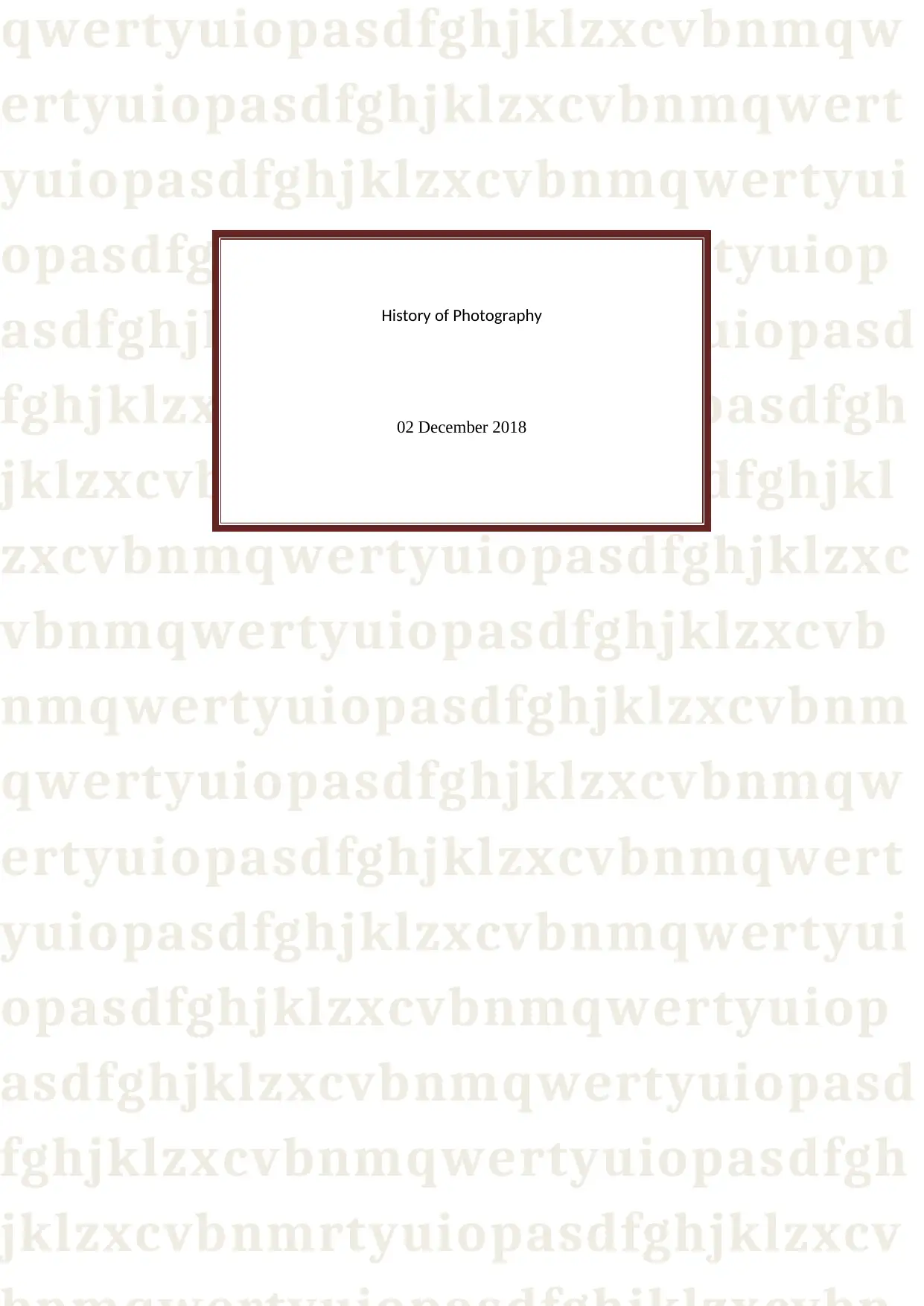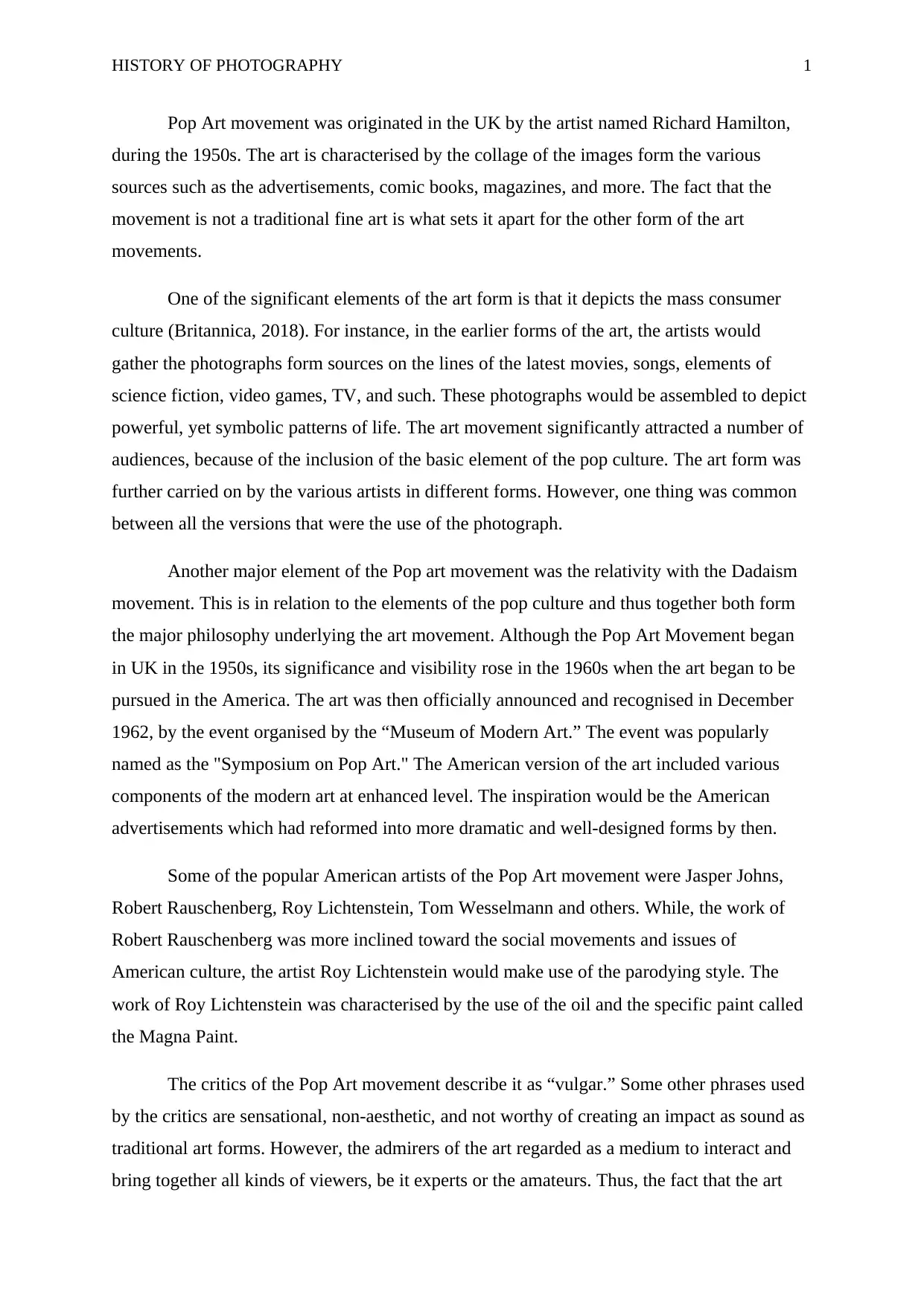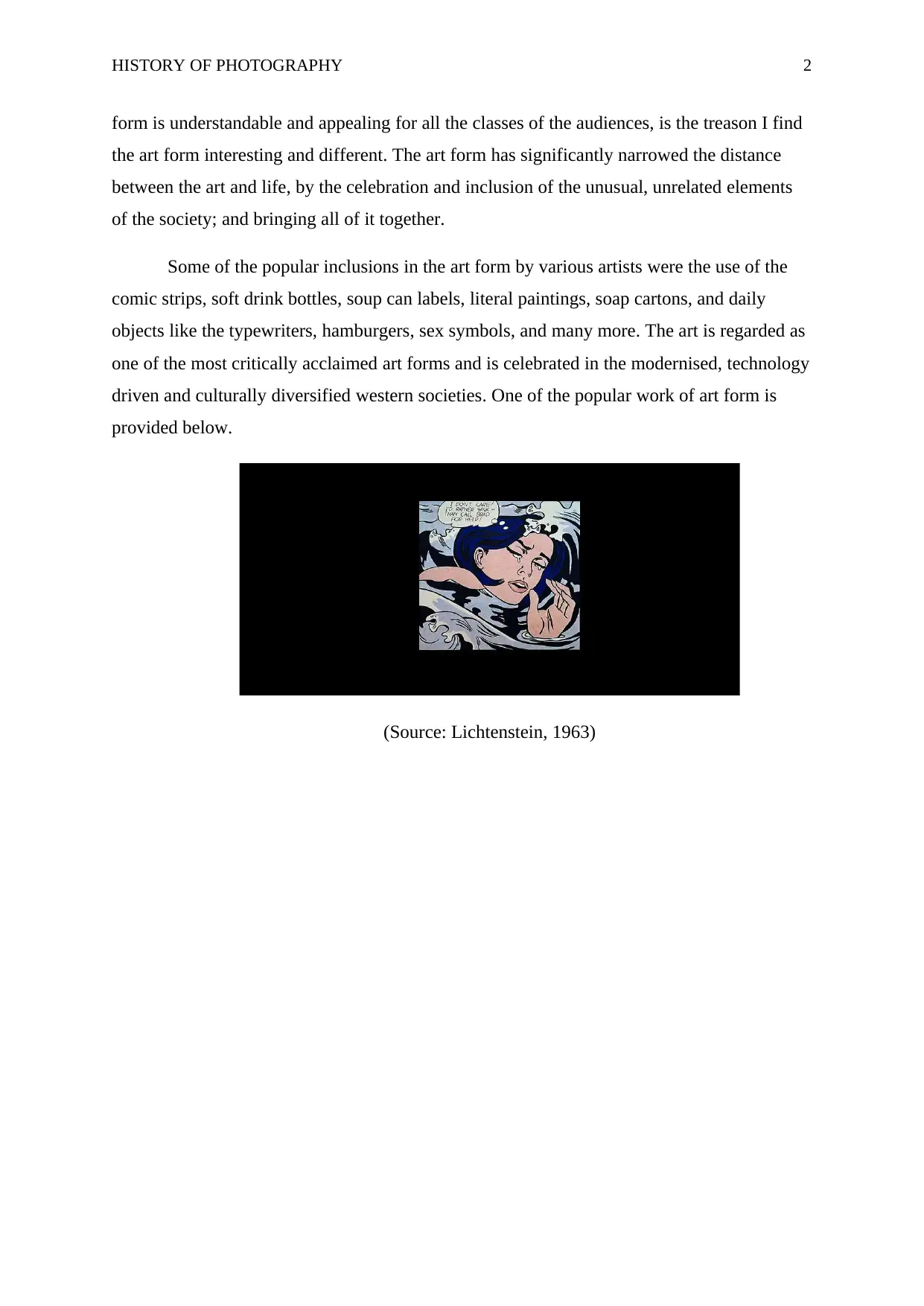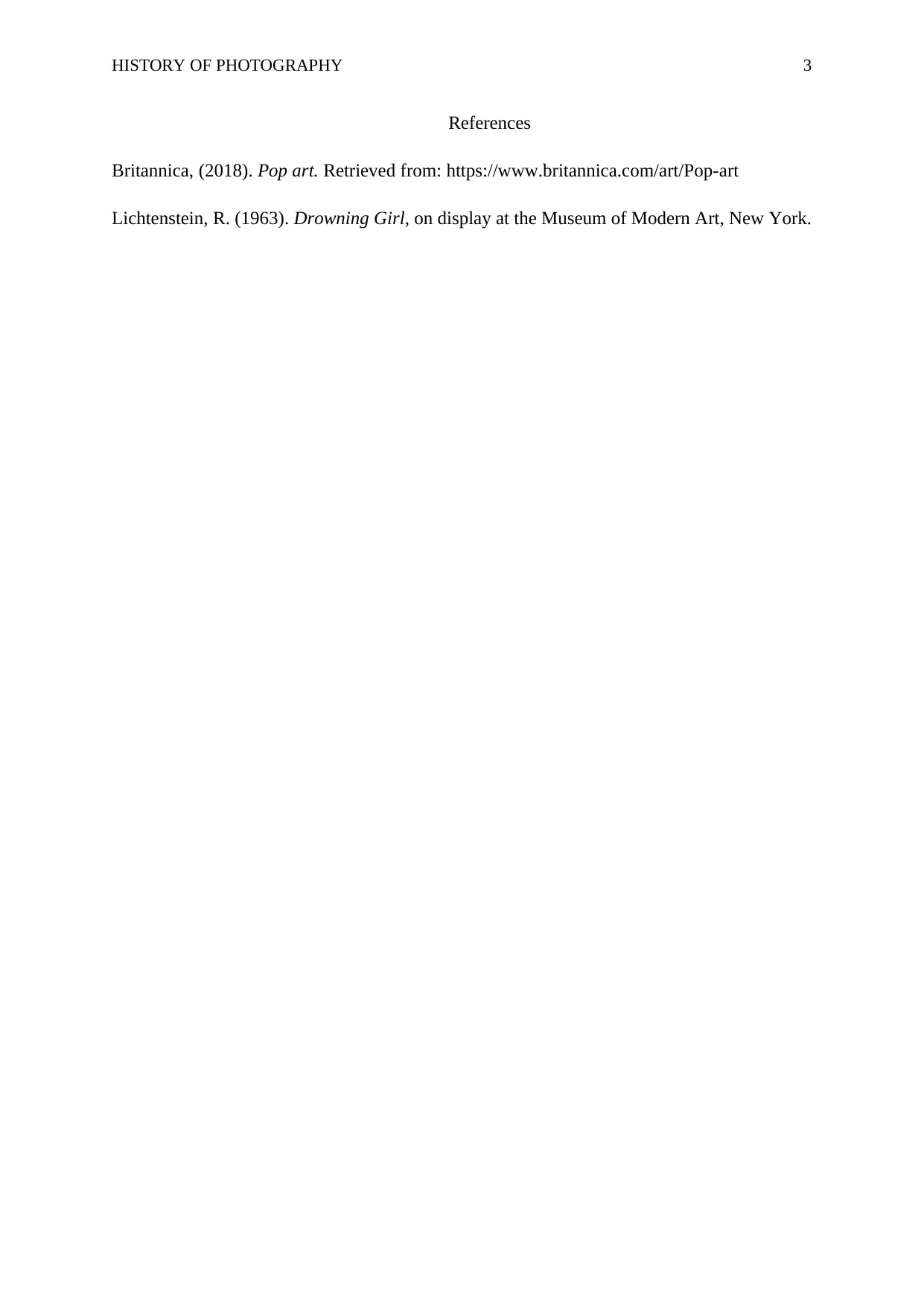The Evolution of Pop Art Movement: A Study in Photography History
VerifiedAdded on 2023/05/29
|4
|737
|487
Essay
AI Summary
This essay explores the Pop Art movement, originating in the UK in the 1950s and gaining prominence in America during the 1960s. Characterized by collages of images from advertisements, comic books, and other sources of pop culture, the movement distinguishes itself from traditional fine art. The essay discusses its relation to Dadaism, its American evolution with artists like Jasper Johns and Roy Lichtenstein, and its reception by critics and admirers alike. It highlights the movement's ability to bridge the gap between art and life by incorporating everyday objects and themes, making it a critically acclaimed art form in modern Western societies. Access more essays and study resources on Desklib.

qwertyuiopasdfghjklzxcvbnmqw
ertyuiopasdfghjklzxcvbnmqwert
yuiopasdfghjklzxcvbnmqwertyui
opasdfghjklzxcvbnmqwertyuiop
asdfghjklzxcvbnmqwertyuiopasd
fghjklzxcvbnmqwertyuiopasdfgh
jklzxcvbnmqwertyuiopasdfghjkl
zxcvbnmqwertyuiopasdfghjklzxc
vbnmqwertyuiopasdfghjklzxcvb
nmqwertyuiopasdfghjklzxcvbnm
qwertyuiopasdfghjklzxcvbnmqw
ertyuiopasdfghjklzxcvbnmqwert
yuiopasdfghjklzxcvbnmqwertyui
opasdfghjklzxcvbnmqwertyuiop
asdfghjklzxcvbnmqwertyuiopasd
fghjklzxcvbnmqwertyuiopasdfgh
jklzxcvbnmrtyuiopasdfghjklzxcv
History of Photography
02 December 2018
ertyuiopasdfghjklzxcvbnmqwert
yuiopasdfghjklzxcvbnmqwertyui
opasdfghjklzxcvbnmqwertyuiop
asdfghjklzxcvbnmqwertyuiopasd
fghjklzxcvbnmqwertyuiopasdfgh
jklzxcvbnmqwertyuiopasdfghjkl
zxcvbnmqwertyuiopasdfghjklzxc
vbnmqwertyuiopasdfghjklzxcvb
nmqwertyuiopasdfghjklzxcvbnm
qwertyuiopasdfghjklzxcvbnmqw
ertyuiopasdfghjklzxcvbnmqwert
yuiopasdfghjklzxcvbnmqwertyui
opasdfghjklzxcvbnmqwertyuiop
asdfghjklzxcvbnmqwertyuiopasd
fghjklzxcvbnmqwertyuiopasdfgh
jklzxcvbnmrtyuiopasdfghjklzxcv
History of Photography
02 December 2018
Paraphrase This Document
Need a fresh take? Get an instant paraphrase of this document with our AI Paraphraser

HISTORY OF PHOTOGRAPHY 1
Pop Art movement was originated in the UK by the artist named Richard Hamilton,
during the 1950s. The art is characterised by the collage of the images form the various
sources such as the advertisements, comic books, magazines, and more. The fact that the
movement is not a traditional fine art is what sets it apart for the other form of the art
movements.
One of the significant elements of the art form is that it depicts the mass consumer
culture (Britannica, 2018). For instance, in the earlier forms of the art, the artists would
gather the photographs form sources on the lines of the latest movies, songs, elements of
science fiction, video games, TV, and such. These photographs would be assembled to depict
powerful, yet symbolic patterns of life. The art movement significantly attracted a number of
audiences, because of the inclusion of the basic element of the pop culture. The art form was
further carried on by the various artists in different forms. However, one thing was common
between all the versions that were the use of the photograph.
Another major element of the Pop art movement was the relativity with the Dadaism
movement. This is in relation to the elements of the pop culture and thus together both form
the major philosophy underlying the art movement. Although the Pop Art Movement began
in UK in the 1950s, its significance and visibility rose in the 1960s when the art began to be
pursued in the America. The art was then officially announced and recognised in December
1962, by the event organised by the “Museum of Modern Art.” The event was popularly
named as the "Symposium on Pop Art." The American version of the art included various
components of the modern art at enhanced level. The inspiration would be the American
advertisements which had reformed into more dramatic and well-designed forms by then.
Some of the popular American artists of the Pop Art movement were Jasper Johns,
Robert Rauschenberg, Roy Lichtenstein, Tom Wesselmann and others. While, the work of
Robert Rauschenberg was more inclined toward the social movements and issues of
American culture, the artist Roy Lichtenstein would make use of the parodying style. The
work of Roy Lichtenstein was characterised by the use of the oil and the specific paint called
the Magna Paint.
The critics of the Pop Art movement describe it as “vulgar.” Some other phrases used
by the critics are sensational, non-aesthetic, and not worthy of creating an impact as sound as
traditional art forms. However, the admirers of the art regarded as a medium to interact and
bring together all kinds of viewers, be it experts or the amateurs. Thus, the fact that the art
Pop Art movement was originated in the UK by the artist named Richard Hamilton,
during the 1950s. The art is characterised by the collage of the images form the various
sources such as the advertisements, comic books, magazines, and more. The fact that the
movement is not a traditional fine art is what sets it apart for the other form of the art
movements.
One of the significant elements of the art form is that it depicts the mass consumer
culture (Britannica, 2018). For instance, in the earlier forms of the art, the artists would
gather the photographs form sources on the lines of the latest movies, songs, elements of
science fiction, video games, TV, and such. These photographs would be assembled to depict
powerful, yet symbolic patterns of life. The art movement significantly attracted a number of
audiences, because of the inclusion of the basic element of the pop culture. The art form was
further carried on by the various artists in different forms. However, one thing was common
between all the versions that were the use of the photograph.
Another major element of the Pop art movement was the relativity with the Dadaism
movement. This is in relation to the elements of the pop culture and thus together both form
the major philosophy underlying the art movement. Although the Pop Art Movement began
in UK in the 1950s, its significance and visibility rose in the 1960s when the art began to be
pursued in the America. The art was then officially announced and recognised in December
1962, by the event organised by the “Museum of Modern Art.” The event was popularly
named as the "Symposium on Pop Art." The American version of the art included various
components of the modern art at enhanced level. The inspiration would be the American
advertisements which had reformed into more dramatic and well-designed forms by then.
Some of the popular American artists of the Pop Art movement were Jasper Johns,
Robert Rauschenberg, Roy Lichtenstein, Tom Wesselmann and others. While, the work of
Robert Rauschenberg was more inclined toward the social movements and issues of
American culture, the artist Roy Lichtenstein would make use of the parodying style. The
work of Roy Lichtenstein was characterised by the use of the oil and the specific paint called
the Magna Paint.
The critics of the Pop Art movement describe it as “vulgar.” Some other phrases used
by the critics are sensational, non-aesthetic, and not worthy of creating an impact as sound as
traditional art forms. However, the admirers of the art regarded as a medium to interact and
bring together all kinds of viewers, be it experts or the amateurs. Thus, the fact that the art

HISTORY OF PHOTOGRAPHY 2
form is understandable and appealing for all the classes of the audiences, is the treason I find
the art form interesting and different. The art form has significantly narrowed the distance
between the art and life, by the celebration and inclusion of the unusual, unrelated elements
of the society; and bringing all of it together.
Some of the popular inclusions in the art form by various artists were the use of the
comic strips, soft drink bottles, soup can labels, literal paintings, soap cartons, and daily
objects like the typewriters, hamburgers, sex symbols, and many more. The art is regarded as
one of the most critically acclaimed art forms and is celebrated in the modernised, technology
driven and culturally diversified western societies. One of the popular work of art form is
provided below.
(Source: Lichtenstein, 1963)
form is understandable and appealing for all the classes of the audiences, is the treason I find
the art form interesting and different. The art form has significantly narrowed the distance
between the art and life, by the celebration and inclusion of the unusual, unrelated elements
of the society; and bringing all of it together.
Some of the popular inclusions in the art form by various artists were the use of the
comic strips, soft drink bottles, soup can labels, literal paintings, soap cartons, and daily
objects like the typewriters, hamburgers, sex symbols, and many more. The art is regarded as
one of the most critically acclaimed art forms and is celebrated in the modernised, technology
driven and culturally diversified western societies. One of the popular work of art form is
provided below.
(Source: Lichtenstein, 1963)
⊘ This is a preview!⊘
Do you want full access?
Subscribe today to unlock all pages.

Trusted by 1+ million students worldwide

HISTORY OF PHOTOGRAPHY 3
References
Britannica, (2018). Pop art. Retrieved from: https://www.britannica.com/art/Pop-art
Lichtenstein, R. (1963). Drowning Girl, on display at the Museum of Modern Art, New York.
References
Britannica, (2018). Pop art. Retrieved from: https://www.britannica.com/art/Pop-art
Lichtenstein, R. (1963). Drowning Girl, on display at the Museum of Modern Art, New York.
1 out of 4
Your All-in-One AI-Powered Toolkit for Academic Success.
+13062052269
info@desklib.com
Available 24*7 on WhatsApp / Email
![[object Object]](/_next/static/media/star-bottom.7253800d.svg)
Unlock your academic potential
Copyright © 2020–2025 A2Z Services. All Rights Reserved. Developed and managed by ZUCOL.

